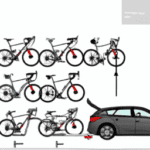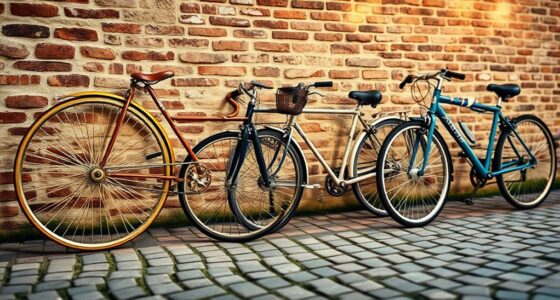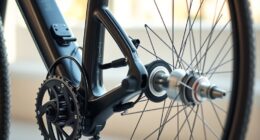Hello fellow bicycle enthusiasts!
I’m here to talk about the importance of locking up your bike with a bicycle rack.
As a bike security writer, I’m passionate about keeping your ride safe and sound, no matter where you are.
Bicycle racks can be an invaluable tool when it comes to keeping your bike secure.
By taking the time to ensure your bike is locked up properly, you can save yourself a lot of heartache and hassle in the long run.
So let’s get into it and learn more about why using a bicycle rack is so important!
Securing Your Bicycle At Home
Securing your bicycle at home doesn’t have to be intimidating. In fact, it’s easier than you may think!
The most important thing is to make sure that you use a good bike rack and the right type of lock. Start by finding a secure place to store your bike – like a bike rack or wall mount.
Then choose a lock that will fit your needs: either a cable lock, chain lock, or U-lock. Make sure to wrap the lock around the frame of your bike, not just the wheel, so it is properly secured.

When choosing a bike rack, consider factors such as material and stability. Bike racks can be made from metal or plastic and should be securely attached to the ground or wall for added security. Also look for racks with loops or hanging arms which allow for more secure locking options.
No matter what kind of lock or rack you end up using, always remember to double check that your bike is locked before walking away!
Taking these few simple steps will ensure that your bike is safe when stored at home and ready to go when you are!
Types Of Bicycle Racks
When it comes to locking your bike, the most important factor is ensuring you have the right type of bike rack. There are many different types of racks available for both commercial and residential use.
The most common bike racks are the bike parking rack, the hitch bike rack and the commercial bike rack.
The first type of rack is a bike parking rack, which is ideal for residential or small commercial spaces. This type of rack allows you to secure your bike in a designated area without having to worry about theft. They come in a variety of styles and sizes and can be easily installed on any surface.
The second type of rack is the hitch bike rack, which is perfect for people who want to take their bikes on trips or store them away while they travel. Hitch racks attach directly to your vehicle’s trailer hitch, making them easy to transport and store securely when not in use. Additionally, many hitch racks can also accommodate multiple bikes at once, making them great for families or groups who want to take their bikes with them on trips.
No matter what type of bike rack you choose, it’s important to select one that meets your needs and budget. Once you’ve chosen a suitable option, securing your ride becomes much easier – all that’s left is learning the best way to lock it up!
The Best Way To Secure Your Bike
When it comes to bike security, there’s nothing like locking your bike to a bike rack. It’s the surest way to make sure that your bike won’t walk away when you’re not looking.
Of course, a good bike lock and cable lock are essential too. A sturdy bike rack and a good quality U-lock or chain lock will give you optimum protection for your two-wheeled pride and joy.
For maximum security, ensure that your U-lock runs through the frame of the bike and at least one wheel. This prevents thieves from being able to remove parts of the bicycle easily. If you’re using a chain or cable lock, make sure it is as secure as possible by running it through both wheels, frame and any other parts such as seats or handlebars.
Taking the time to properly secure your bike with a high-quality bike rack and lock ensures peace of mind when you leave your bicycle unattended. Knowing that you’ve taken all necessary steps to protect your beloved ride is invaluable – now let’s take a look at some of the benefits of using a bike rack!
Benefits Of Using A Bike Rack
Securing your bike with a bike rack is an invaluable way to protect it from theft and vandalism. It’s like a knight in shining armor for your trusty steed!
There are numerous benefits to using a bike rack, and I’m here to tell you why they are worth the investment.
Firstly, bike racks provide an extra layer of security that cannot be achieved by just using a cable lock or chain. With a bike rack, you can secure your frame and both wheels to the ground, making it much harder for thieves to get away with your beloved bicycle.
Secondly, many bike racks come with features such as built-in locks or brackets for additional security devices. This allows you to make sure your bicycle is securely locked up without having to worry about leaving something behind.
Thirdly, bike racks come in all sorts of shapes and sizes so you can find one that fits perfectly into the space available for it.
And lastly, installing a bike rack does not require any major renovations or construction – just some basic screwing and bolting will do the trick!
With all these benefits in mind, investing in a reliable bike rack is definitely worth it if you want to keep your beloved ride safe and sound! Now let’s look at how to install one properly….
How To Install A Bike Rack
Now that you know the benefits of using a bike rack, it’s time to learn how to install one. Installing a bike rack can provide an effective way to secure your bicycle from bike thieves and ensure your bicycle is stored safely. To do this, you need to have the right tools and materials at hand. Here’s a table to help you get started:
| Item | Purpose |
|---|---|
| Bike Rack | Secures the frame of your bicycle in place for storage or transport |
| Cable Lock | Attaches the frame of your bicycle to the bike rack for extra security against theft |
| Hammer/drill with screws/bolts | Used to attach the bike rack securely into place on any surface |
Installing a bike rack requires some planning and preparation. Start by measuring out where it will be installed so that it can fit securely in its new location. Once you’ve done this, you can begin attaching your bike rack into place. Use your hammer or drill with appropriate screws or bolts depending on what type of surface it’s being attached onto. Finally, use a cable lock to attach your bicycle’s frame onto the bike rack for extra security against theft. Taking these steps will help ensure that everything is properly secured and in place when you’re ready to store or transport your bicycle!
Now that we have covered all of the components for installing a bike rack, let’s look at some tips for getting everything set up correctly without any problems.
Tips For Installing A Bike Rack
Installing a bike rack is the very first step in protecting your bike from thieves. The best way to lock your bike is to have a secure place to lock it. A bike rack is the ideal spot for this, as it allows you to lock your bike in place with a cable lock or other locking mechanism.
When selecting and installing your bike rack, make sure that it is stable and mounted to something secure like concrete or metal. This will ensure that the rack can’t be easily removed by anyone who wishes to steal your bicycle.
Additionally, you should also check that the area around the rack is well-lit and visible so that potential thieves won’t feel comfortable taking your bike.
By using a combination of good security practices like choosing an appropriate location, properly fastening the bicycle rack, and using a secure locking mechanism, you can rest assured knowing that your bike will stay safe while locked up in its new home. Keeping these tips in mind will help you lock your bike properly and protect it from theft.
Different Ways To Lock Your Bike
When it comes to bike security, locking your bicycle to a rack is often the best option. A bicycle rack provides an anchor point for your bike lock and makes it harder for thieves to take your bike.
The most secure bike locks are usually cable locks or U-locks. Cable locks are relatively easy to use and are great for locking up multiple bikes at once. They’re not as strong as U-locks, but can be used in combination with them for extra security.
U-locks are much more secure than cable locks and offer greater protection against thieves. However, they’re heavier and more expensive than cable locks and may not fit around all racks. When choosing the right lock, always consider cost and weight in addition to security features.
It’s worth investing in a good quality lock that will keep your bike safe from theft while also being comfortable to carry around on rides.
Moving onto the next topic: securing your bicycle with straps…
Secure Bicycle Lock Straps
When it comes to bike security, one of the best solutions is to use a lock strap. A lock that’s off the ground and out of sight is a great way to deter theft.
For instance, if you have a bicycle rack in your garage or on the street, you can easily secure your bike with a lock strap. You can keep your bike locked open so that it’s still accessible when you need it.
The most important thing about using a lock strap is that you want to make sure it’s securely attached to your bike frame. If the strap isn’t fastened tightly enough, there’s always the risk that someone could cut through the lock.
Many cyclists opt for the highest quality straps available for maximum security. Bike lockers are also available if you need extra protection from theft or vandalism.
This type of security measure can give you peace of mind knowing that your bike is safe while away from home or in storage.
Next up, we will discuss how to attach a lock strap to your bike in order to create an effective deterrent against theft and vandalism.
How To Attach Lock Strap To Your Bike
When it comes to locking your bicycle, you want to make sure that your bike is secure. A bicycle rack is the perfect way to do this, as it provides a solid anchor point for your lock and allows you to easily access the bike. Before you start locking up your bike, check that the type of rack you are using is suitable for securing your bike. Depending on what kind of lock you have, some types of racks may be better than others.
Once you have chosen a suitable rack, it’s time to attach the lock strap and secure your bike. To do this, run the lock strap around the frame of your bike and through both wheels if possible. Make sure that the strap is tight so that it cannot be removed without difficulty. You should also make sure that any accessories such as bags or baskets are secured with an additional lock or by attaching them securely to the frame.
Now that your bike is locked up properly with a bicycle rack, all that’s left to do is choose the right type of lock for extra security. Different locks offer varying levels of protection so it’s important to know which one will best suit your needs – we’ll explore different types of locks in more detail in our next section.
Secure Bicycle Lock Types
Now that you know how to attach your lock strap to your bike, let’s talk about the types of locks available on the market. Whether you own a mountain bike or a cruiser, security for your bike is important. That’s why it’s essential to choose a lock that fits your needs and offers reliable protection.
When shopping for a bike lock, pay attention to the rating system used by manufacturers. A higher-rated bike lock typically provides greater security than its lower-rated counterparts. Look for locks rated U-lock, chain and cable or integrated, depending on your budget and level of security desired.
U-locks are great for locking up bikes in urban environments, while chain and cable locks provide more flexibility when securing multiple bikes in one area. Integrated locks offer convenience but can be expensive and require regular maintenance.
No matter what type of lock you choose, make sure it fits securely around the frame and wheel of your bike so it can’t be removed easily by thieves. If possible, use two different types of locks together for added protection—for example, an U-lock combined with a cable or chain lock—as this will significantly reduce the chances of someone stealing your ride!
With the right combination of locks, you can feel confident that your bike is safe no matter where you park it.
Benefits Of Using Car Racks
Using car racks to keep your bike secure is an invaluable investment for cyclists of all levels. Whether you’re a recreational rider, a commuter or a professional racer, having the right bike rack is crucial for protecting your ride.
As any cyclist knows, the best way to protect your bike is to lock it up with a good quality lock and secure it to a car rack.
When it comes to protecting your bike, investing in a quality car rack is key. The right car rack will not only keep it safe from theft but also provide extra stability when transporting your bike.
With many different types of car racks available, you can choose one that best suits your needs. From racks designed specifically for mountain bikes or road bikes to trunk-mounted racks with adjustable arms and straps, there’s something out there for everyone.
No matter what type of car rack you choose, make sure you always lock the frame of your bike and use a heavy-duty chain or U-lock to keep it secure. This will give you peace of mind that your beloved ride won’t be stolen while you’re away from home!
Car Racks For Bikes
It’s important to keep your bike secure, especially if you’re leaving it at home or taking it with you on the go. Using car racks for bikes is a great way to make sure your bike stays safe, and there are a few ways to lock your bike in a bike rack for added security.
Here’s a 4-step guide to help get you started:
- When bringing your bike home, make sure you have the right kind of lock that can be secured to the rack. Chain locks and U-locks are some of the most common types of locks you can use.
- Next, secure your bike in the rack by looping the chain or U-lock around one of the tubes of the frame and through one of the slots in the rack. This will help ensure that your bike remains in place while it’s locked up.
- You’ll also want to double check that your lock is secure before leaving it unattended for any period of time. Make sure all parts are tightly fitted together and that no gaps exist between them so no one can tamper with it and steal your bike!
Now that we’ve covered how to properly lock up your bike using car racks, let’s take a look at some tips for securing it even further when you’re out and about or leaving it at home overnight.
Tips For Securing Your Bike
As a cyclist, you know that the security of your bike is paramount. It’s often said that it’s better to be safe than sorry, and when it comes to your two-wheeled companion, nothing could be more true.
But with all the different ways to lock your bicycle, what’s the best way?
When it comes to securing your good bike, one lock isn’t enough. You need to have multiple ways of locking up your bicycle in order to deter potential thieves.
It’s important to invest in a good quality bicycle rack that can withstand tampering and is securely mounted onto a wall or floor if necessary. Additionally, make sure to use U-locks or heavy duty chains on both the frame and wheels wherever possible.
It’s also important to remember that visibility is key when it comes to bike security. Make sure your bike is in an area with good lighting and plenty of foot traffic so that anyone thinking about stealing it will think twice before doing so.
By following these simple tips for securing your bike, you can help ensure that it stays where it belongs – with you!
Bike Security Tips
When it comes to bike security, one of the most important tips is to always lock your bike with a bicycle rack. A heavy lock is also essential, as it will be much more difficult for someone to pick. Taking the time to secure your bike properly can make a huge difference in deterring theft.
Another tip is to avoid leaving your bike out in the open – even if you have locked it up securely on a bike rack. Try and leave it somewhere well-lit and in view of passersby; this will discourage potential thieves from trying anything sneaky.
It’s also useful to invest in an anti-theft device such as a GPS tracker or alarm. Many of these devices can alert you through an app if anyone attempts to tamper with your lock or attempt to steal your bike.
With all these tips in mind, you should be able to ensure that your beloved bicycle stays safe and secure wherever you take it!
Now let’s look at the long-term impact of bike security…
Long-Term Impact Of Bike Security
As the saying goes, “Better safe than sorry” and this is especially true when it comes to bike security. Securing your bicycle with a bicycle rack is the best way to protect your bike from theft.
It is possible to lock your bike in almost any location, making it easier for you to park it and keep it safe.
There are two primary locks that cyclists should consider before locking their bikes: a U-lock and a cable lock. U-locks provide the highest level of security because they are harder to break into than cable locks. Cable locks, on the other hand, can be easily cut by wire cutters, so they should only be used as a secondary lock.
When choosing a bike rack for your bike, consider where you plan to park it and how much security you need. There are several types of racks available, including wall-mounted racks and surface-mounted racks, which can provide extra protection for your bike.
No matter what type of rack you choose, make sure it has enough space for both your primary and secondary lock so that your bike stays safe wherever you go.
Frequently Asked Questions
What Is The Best Bike Lock To Buy?
When it comes to bike security, the best bike lock to buy is one that provides maximum protection.
U-locks are the go-to choice for many cyclists, as they offer a high level of security at an affordable price. They provide a strong deterrent against theft and can easily be attached to a bicycle rack or other secure fixture.
For more peace of mind, chain locks are an option too – they’re heavier but more secure than U-locks and can be used in combination with other security measures such as alarms.
Whichever lock you choose, make sure it’s fit for purpose and you’ll be able to enjoy your ride with greater confidence!
How Much Does A Bike Rack Typically Cost?
When it comes to bike security, you want the best of the best. But you don’t have to break the bank to protect your beloved two-wheeler.
A good bike rack can cost anywhere from a few bucks up to hundreds of dollars – depending on the size and material.
So no matter what your budget is, you’re sure to find something that’ll keep your bike safe and sound.
Are There Alternatives To Bike Racks For Securing My Bike?
Yes, there are alternatives to bike racks for securing your bike.
U-locks and cable locks are both popular options that are designed to keep your bike safe and secure. Each type of lock comes with its own pros and cons, so it’s important to do your research before deciding which one is right for you.
U-locks are usually more expensive, but they provide a higher level of security than cable locks. Cable locks are typically cheaper, but not as strong as U-locks.
How Do I Know If My Bike Is Secure Enough?
Securing your bike can seem like a daunting task, but it doesn’t have to be. Think of it like building a house – you want to make sure all the pieces fit together correctly and the structure is solid enough to keep out any would-be intruders.
When it comes to bike security, there are a few key points you should keep in mind:
- Make sure your lock is secured tightly around the frame and wheels.
- Double-check that all fastenings are secure.
- Look for any weak spots where someone could break in.
If everything checks out and your bike feels sturdy, chances are it’s secure enough!
What Are The Differences Between A Bike Lock And A Lock Strap?
When it comes to bike security, a bike lock and a lock strap are two of the most popular options.
Bike locks are typically made from metal and feature a key or combination-based locking mechanism. This offers a secure solution for locking your bike in place, as it’s hard for thieves to break without the right tools. However, they can be bulky and hard to carry around with you.
Lock straps, on the other hand, are more lightweight and easier to transport. They wrap around your frame and can be secured with an integrated padlock or cable lock. While they may not offer as much protection as a bike lock, they are still an effective way to prevent theft if used correctly.
Conclusion
It’s important to remember that bike theft is on the rise, with an estimated 2 million bicycles stolen every year in the United States alone. That’s why it’s so important to invest in a good bike lock and bicycle rack.
Doing so will not only protect your investment, but also provide peace of mind knowing that you’re taking proactive steps to ensure your bike remains safe and secure. Whether you choose an innovative new lock strap or a traditional chain with padlock, there are plenty of options available to keep your bike safe from thieves.
By investing in quality locks and racks, you can rest assured that your beloved two-wheeler will remain exactly where you left it!
















